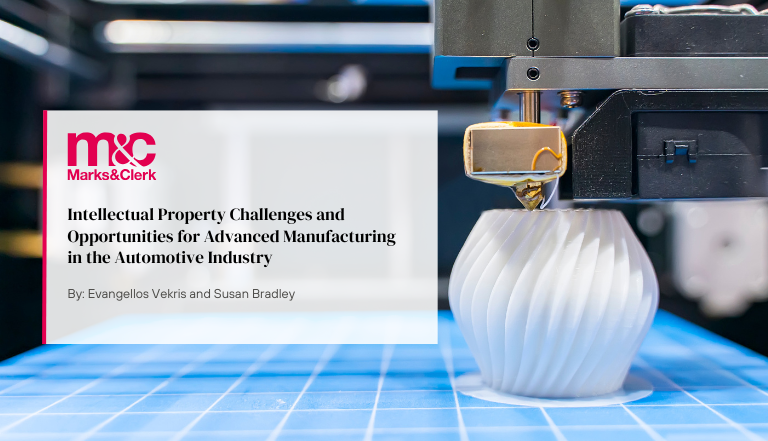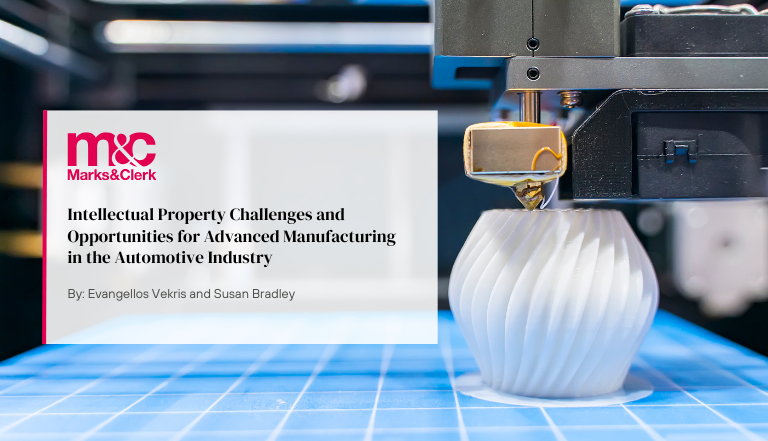This article is based on an extended abstract published in the proceedings of the 63rd Annual Conference of Metallurgists (COM 2024) by Marks & Clerk Managing Associate, Evangellos Vekris.
In many industry sectors, diverse intellectual property portfolios, including patent portfolios, are an important part of the commercialization plans for companies of all sizes. A diverse patent portfolio may include multiple patents for key innovations in one product, or across an entire product family, and with coverage across multiple global jurisdictions. When developed strategically and in line with business plans a diverse patent portfolio can enable a company to secure a monopoly within the market and can also increase the value of a company’s intangible assets and keep competitors at bay.
In the automotive industry, in which the ultimate product (namely, the automobile) consists of subproducts assembled by different processes, with complex supply chains, it can be difficult for a company to remain competitive. With suppliers in emerging economies competing in product segments with traditionally high labour costs (namely, in the 20 percent range), unless the subproduct or process is protected by one or more patents, it can be especially challenging. For this reason, most automotive companies based in developed economies focus their business model on only developing and manufacturing products that can be protected through some form of enforceable intellectual property protection, such as a patent or registered design.
Currently, one area of innovation amongst automotive companies is the development of new, advanced manufacturing technologies, and in particular additive manufacturing or “3D printing” technologies. Additive manufacturing is attractive to the automotive industry primarily for cost reduction reasons, but also for other reasons such as quicker production time, customizability and versatility of parts design, and better materials usage efficiency.
One recent example of the use of additive manufacturing in automotive is Tesla, Inc., who in September 2023 announced the adoption of 3D printing of sand to form giant sand molds for casting, to complement their overall suite of scaled-up “giga” production methodologies [1]. The approach involves fabricating nearly an entire automotive underbody as a large single part, that otherwise would have required welding together over 400 smaller parts formed as individual stampings. Creating the mold using 3D printed sand allows Tesla to overcome the general rule that any increase in size of a conventional casting requires a nearly exponential increase in cost. Notably, Tesla anticipates the cost of the casting technology using sand 3D printing to decrease from about US$4 million to about US$120,000.
More recently, Additive Drives GmbH announced in January 2024 the development of an electric motor for automotive electric vehicles made with 3D printing [2]. Advantageously, the electric motor is ultra-efficient and provides 45% greater power density than electric motors made by conventional methods. The electric motor also reduces AC losses by 50% and provides energy savings of up to 50%. The particular benefits provided by the 3D printing are physical and very real; 3D printing enables i) motor housings having special geometries capable of providing optimized cooling, and ii) advanced aluminum and copper alloys having electrical properties superior to cold-drawn wire, to be readily produced.
An additional benefit of manufacturing automotive parts using 3D printing techniques is the ability to “lightweight” components whilst maintaining their strength. BMW recently launched an aluminium-alloy engine cover [3] with an intricate internal lattice structure that significantly reduces weight. Such complex geometries would be difficult if not impossible to produce using conventional manufacturing methods. Automotive parts produced in this way do more than just replace traditional components; as a result of its lattice structure, the BMW engine cover has enhanced airflow and heat dissipation performance, while its lighter, semi-hollow format improves fuel efficiency and reduces emissions.
However, as encouraging and exciting as these early adoptions of additive manufacturing may be for automotive companies, it is important to take into consideration several potential challenges associated with intellectual property portfolios, as diverse and geographically inclusive as they may be.
First, existing intellectual property protection may not necessarily keep pace with this technological development and may be limited to only “traditional” manufacturing processes and not offer protection against 3D printed parts. In other words, it is critical for automotive patent owners to ensure that their existing monopoly is not coloured by features of conventional manufacturing processes, be they “traditional” structural product features (for example, an underbody comprising an assembly of individual parts) or assembly steps (for example, a method of forming an underbody by joining individual parts) that may now be rendered obsolete by 3D printing. Patent owners will therefore need to review existing patents and vet the claims of invention to determine whether they contain language that may now be obsolete in view of recently developed additive manufacturing techniques. The need to modify conventional patent claim language is discussed in more detail in our white paper “Intellectual Property in an age of 3D Printing”.
Second, automotive companies will need to rethink the territorial coverage of their IP portfolio. With 3D printing technology, copying can take place anywhere in the world and is likely to take place in key destination markets. As the cost of 3D printing technology drops, it is expected that manufacturing of 3D printed automotive parts will undergo a shift away from traditionally strong automotive manufacturing countries into other countries where autos are destined for sale. Automotive companies are therefore encouraged to revisit their IP strategy and ensure their IP portfolios are protected in destination markets rather than focusing only on traditionally strong automotive manufacturing countries.
The global automotive additive manufacturing market is anticipated to grow from USD 4.43 billion in 2024 to a massive USD 15.33 billion by 2031 [4]. This projected growth is only a few years away; to ensure effective protection of their innovative technologies, automotive companies need to take action now to check that their IP protection is, and will be, fit for purpose in the AM market of the near future.
References
- 3dprint.com (2023) Tesla’s 3D printed sand molds: The key to cheaper EVs. https://3dprint.com/303449/teslas-3d-printed-sand-molds-the-key-to-cheaper-evs/, last accessed 2024/03/24
- EV Tech Insider (2024) 3D printed EV motors: 45% higher power density, more design freedom, rapid time to market. https://evtechinsider.com/2024/01/11/3d-printed-ev-motors-45-higher-power-density-more-design-freedom-rapid-time-to-market/, last accessed 2024/03/24
- BOYI Technology (2024) https://www.boyiprototyping.com/3d-printing-guide/3d-printing-automotive-parts/
- GlobeNewsWire (2024) 3D Printing in Automotive Manufacturing Market 2024 - 2031: Trends, Growth, and Opportunities | Exactitude Consultancy https://www.globenewswire.com/news-release/2024/11/21/2985676/0/en/3D-Printing-in-Automotive-Manufacturing-Market-2024-2031-Trends-Growth-and-Opportunities-Exactitude-Consultancy.html



